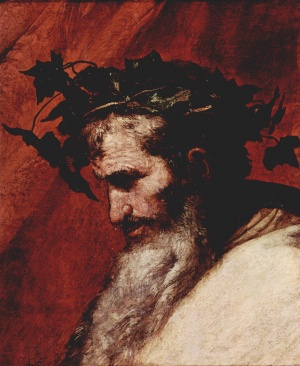Difference between revisions of "Salmakhamer"
Trismegistus (talk | contribs) m |
Trismegistus (talk | contribs) m |
||
| Line 1: | Line 1: | ||
[[File:JosédeRibera+Dionysus+17thC+PublicDomain.jpg|thumb|300px|Salmakhamer crowned with a wreath of laurel]] | [[File:JosédeRibera+Dionysus+17thC+PublicDomain.jpg|thumb|300px|Salmakhamer crowned with a wreath of laurel]] | ||
| − | b ca 38 AS, [[Uthurnia]]; d ca 45 AI, ? [[Elántuventh]]. The Prophet-Priest-Reformer of Midretassene Heritage, Salmakhamer is famed throughout the annals of history as the priest and missionary who left his native [[Kalama]] to renew piety and devotion to the Isxinthion gods. Historians place his date of birth at variously 30 to 50 years before the first year of his ministry which marks the beginning of the Isxinthion Calendar. Chroniclers usually put [[Uthurnia]] as his place of birth. Elántuventh claims the privilege of holding his burial site in the [[Mausoleum of the Heliophant Eternal]]. It is not certain that Salmakhamer died in Elantuventh. His family was of mixed [[Shardanian]]-[[Midretasso|Midretassene | + | b ca 38 AS, [[Uthurnia]]; d ca 45 AI, ? [[Elántuventh]]. The Prophet-Priest-Reformer of Midretassene Heritage, Salmakhamer is famed throughout the annals of history as the priest and missionary who left his native [[Kalama]] to renew piety and devotion to the Isxinthion gods. Historians place his date of birth at variously 30 to 50 years before the first year of his ministry which marks the beginning of the Isxinthion Calendar. Chroniclers usually put [[Uthurnia]] as his place of birth. Elántuventh claims the privilege of holding his burial site in the [[Mausoleum of the Heliophant Eternal]]. It is not certain that Salmakhamer died in Elantuventh. His family was of mixed [[Shardanian]]-[[Midretasso|Midretassene]] heritage. |
The mission of Salmakhamer established a strong boundary between lawful and chaotic divinities that had not existed previously. Modern scholarship has explored that idea that the distinction between today's Isxinthion Gods and Chaos Gods was not so crisp before Salmakhamer and some gods such as Rhio could have easily fallen either way on the division between Chaos and Law. In deep antiquity, Lygdamion for example, was not a 'chaos god' anymore than Amrulon was an Isxinthion God. They were seen as divine members of a worldwide race of gods where the notion of 'pantheon' was closer to a family of gods. | The mission of Salmakhamer established a strong boundary between lawful and chaotic divinities that had not existed previously. Modern scholarship has explored that idea that the distinction between today's Isxinthion Gods and Chaos Gods was not so crisp before Salmakhamer and some gods such as Rhio could have easily fallen either way on the division between Chaos and Law. In deep antiquity, Lygdamion for example, was not a 'chaos god' anymore than Amrulon was an Isxinthion God. They were seen as divine members of a worldwide race of gods where the notion of 'pantheon' was closer to a family of gods. | ||
Salmakhamer taught the Isxinthion Gods which differed from the Kalaman Gods of Kalama. Salmakhamer is thought to have been part Kalaman and part Midretassene in heritage. Salmakhamer's conception of the family of the Isxinthion Gods is the basis for most of the relations presented in the [[Interpretatio Isxinthiona]]. | Salmakhamer taught the Isxinthion Gods which differed from the Kalaman Gods of Kalama. Salmakhamer is thought to have been part Kalaman and part Midretassene in heritage. Salmakhamer's conception of the family of the Isxinthion Gods is the basis for most of the relations presented in the [[Interpretatio Isxinthiona]]. | ||
| + | |||
| + | According to records, Salmakhamer fasted eight days to cleanse a temple site and to defeat the lingering influence of Lygdamion and other [[Chaos Gods|chaos gods]]. | ||
=See Also= | =See Also= | ||
Revision as of 23:44, 27 May 2022
b ca 38 AS, Uthurnia; d ca 45 AI, ? Elántuventh. The Prophet-Priest-Reformer of Midretassene Heritage, Salmakhamer is famed throughout the annals of history as the priest and missionary who left his native Kalama to renew piety and devotion to the Isxinthion gods. Historians place his date of birth at variously 30 to 50 years before the first year of his ministry which marks the beginning of the Isxinthion Calendar. Chroniclers usually put Uthurnia as his place of birth. Elántuventh claims the privilege of holding his burial site in the Mausoleum of the Heliophant Eternal. It is not certain that Salmakhamer died in Elantuventh. His family was of mixed Shardanian-Midretassene heritage.
The mission of Salmakhamer established a strong boundary between lawful and chaotic divinities that had not existed previously. Modern scholarship has explored that idea that the distinction between today's Isxinthion Gods and Chaos Gods was not so crisp before Salmakhamer and some gods such as Rhio could have easily fallen either way on the division between Chaos and Law. In deep antiquity, Lygdamion for example, was not a 'chaos god' anymore than Amrulon was an Isxinthion God. They were seen as divine members of a worldwide race of gods where the notion of 'pantheon' was closer to a family of gods.
Salmakhamer taught the Isxinthion Gods which differed from the Kalaman Gods of Kalama. Salmakhamer is thought to have been part Kalaman and part Midretassene in heritage. Salmakhamer's conception of the family of the Isxinthion Gods is the basis for most of the relations presented in the Interpretatio Isxinthiona.
According to records, Salmakhamer fasted eight days to cleanse a temple site and to defeat the lingering influence of Lygdamion and other chaos gods.
See Also
- Anno Isxinthionum
- Ante Salmakhamer
- Coming of Salmakhamer
- Common Year
- Elántuventh
- Isxinthion Gods
- Kalamantizing Philosophers
- Uthurnia
| This article is a stub. It requires further development by the creator. |
